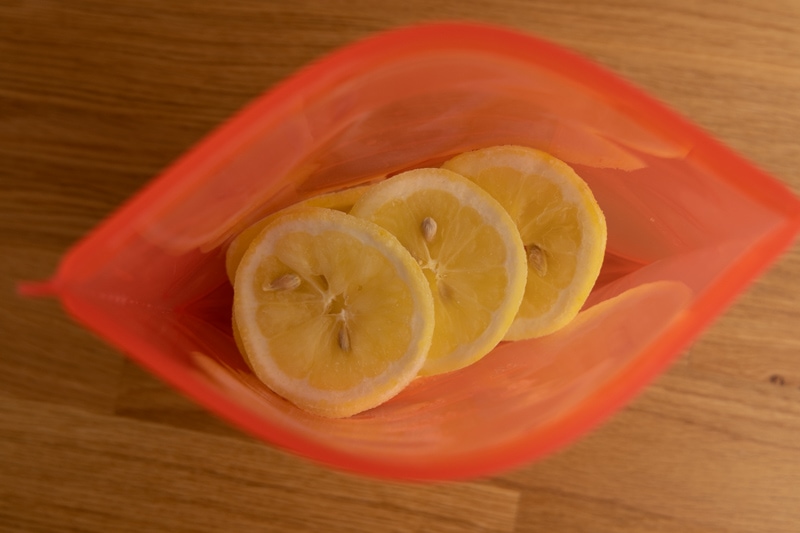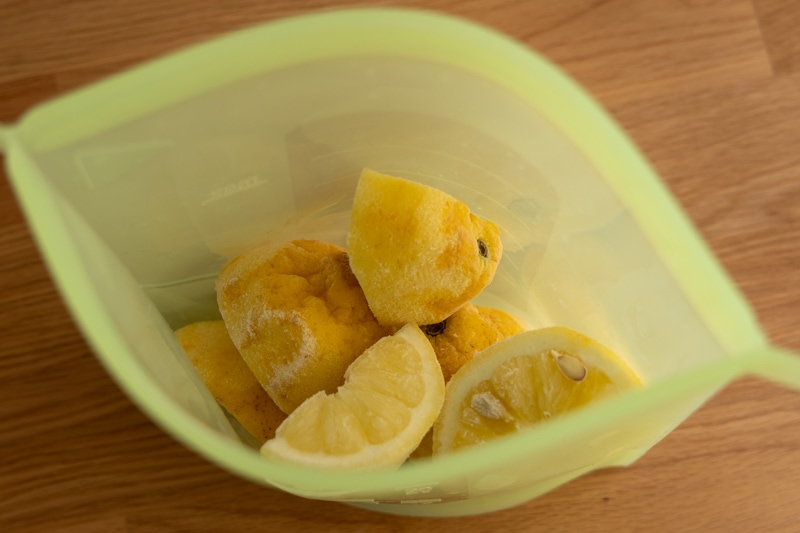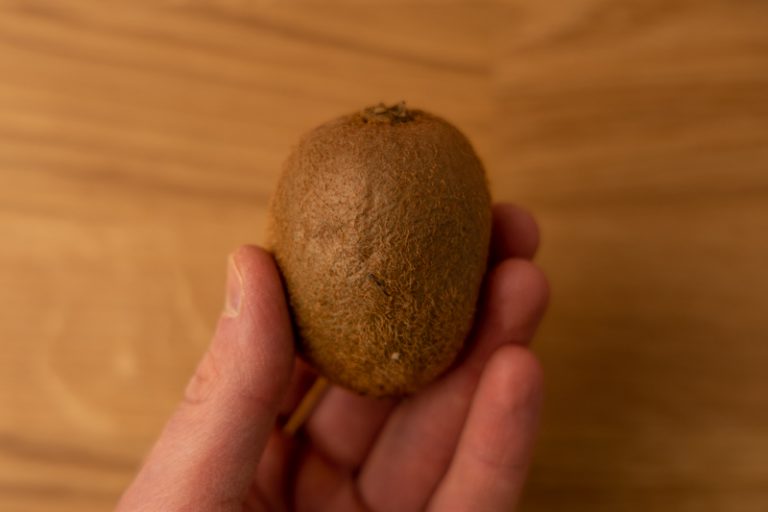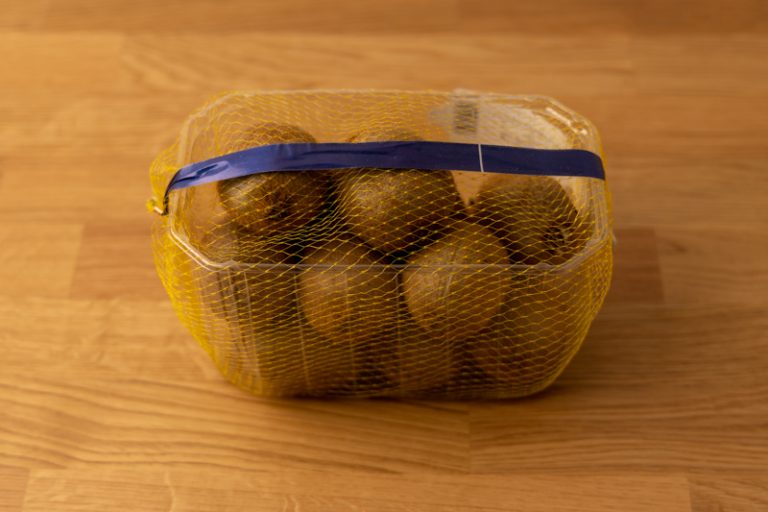Can You Freeze Lemons? [Whole Lemons, Wedges, and Slices]
Here’s a comprehensive guide to freezing lemons. Learn how to go about freezing whole lemons, wedges, and lemon slices, and how to use them.
Got too many lemons on hand and thinking about freezing? Or maybe you have a few quarters or slices stashed in the fridge that you’d like to preserve for later?
So, can you freeze lemons?
You can freeze lemons whole, halved, quartered, or sliced. Each option has its pros and cons and slightly different uses. You should know how you’ll use that lemon after thawing to choose the best way to freeze it.
Now, that’s not super helpful, isn’t it?
That’s because there’s way more to it, and you cannot answer the given question in a sentence or two.
But before we get to the nitty-gritty of freezing lemons, you should first make sure that freezing the fruit is the best solution to your problem. Because in many cases, it’s not.

Should You Freeze Lemons?
First, whole lemons last 3 to 5 weeks in the fridge, so if that’s what you have on hand, you might still have some time to use them, and you don’t necessarily need to freeze them just yet.
(Fresh whole lemons are better than frozen ones, as you might imagine.)
But if yours are already cut up, you only have a couple of days to use or freeze them. And that means now is the time to make the decision.
Related: How long do lemons last?
Next, most recipes that call for lemons don’t really require you to have the fruit itself on hand. Instead, they either use lemon juice, lemon zest, or both.
So unless you need a few lemon slices to place on top of your baked salmon or garnish your lemon cake, you’re probably fine if you only have the juice and perhaps some zest.
And luckily for you, you can both freeze lemon juice and freeze lemon zest. Plus, both take much less space in the freezer than the whole fruit and are ready to use without any further processing.
In other words, by freezing the juice and/or the zest, you front-load the work.
Of course, if you don’t quite have the time to process the lemons now, or you need to have the fruit and not just the juice or zest, freezing lemons is the way to go.
(If you’re wondering if you can freeze limes, the same arguments can be made for and against doing so.)
Do Lemons Freeze Well?
Lemons soften noticeably after being frozen and thawed. You can still juice or zest them, but using them in a dish that doesn’t involve cooking or baking the lemons isn’t a good idea.
Those slices, quarters, or halves look soft and beat up after defrosting, and that’s not something you want to use as a drink garnish or leave on the table for guests to get freshly squeezed lemon juice.
That said, you can still use defrosted lemons in any dish that’s cooked on the stove or baked in the oven. Lemons become soft and squishy after heat treatment anyway, so it doesn’t matter if they were soft or not.
That’s what you need to know about how freezing affects lemons.
Now, before we get into which method you should choose depending on your needs, let’s briefly touch upon zesting lemons.
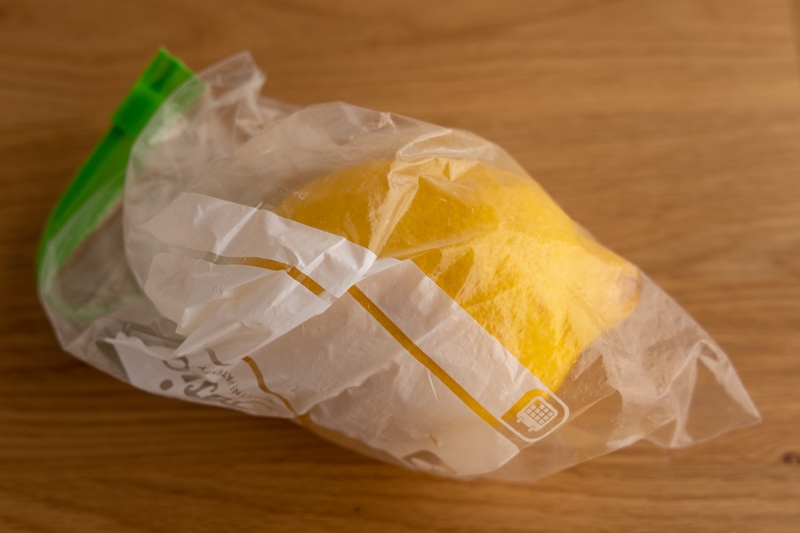
Zesting Frozen Lemons
If you know you’re going to (or might need to) zest that frozen lemon, remember that you’ll do this while it’s still frozen. That’s because zesting a soft, defrosted lemon is considerably more difficult and frustrating than working with a firm, frozen one.
The only downside is that a frozen lemon is ice cold (duh!) and zesting one isn’t the most pleasant of activities.
Zesting frozen lemons means that you should dewax them before freezing, if that’s what you typically do. Dewaxing a frozen lemon is impossible without partially defrosting it, and you definitely don’t want to refreeze it just to zest it.
(If you don’t remove wax from your lemons before zesting, there’s nothing to worry about.)
Having that out of the way, let’s talk about the freezing options you have.

Freezing Lemons Summary
| Freezing Method | How to Use | Defrosting |
|---|---|---|
| Whole lemon | Zesting, juicing, slicing and using slices in baked dishes & goods | Fridge |
| Lemon wedges | Zesting, juicing | Fridge |
| Lemon slices | Baked dishes & goods | Fridge or add frozen |
Freezing a Whole Lemon
How to Freeze a Whole Lemon
- Place the lemon in a freezer bag. Squeeze out the air, and add a label with the name and date if that’s helpful.
- Freeze.
That’s it – freezing doesn’t get any easier than that. You throw the fruit in the freezer (wrapped)—no need for pre-freezing or any of that.
While that lemon can sit for years in the freezer, it’s probably best to use it within 3 to 6 months for the best quality. And by best I mean decent because it’s going to be a far cry from a fresh lemon, even if it’s frozen for only a day.
Freezing the citrus fruit whole is also great when you’re freezing oranges. In theory, you could freeze a whole grapefruit this way too, but peeling it after defrosting would be super annoying and take ages. Instead, I suggest freezing grapefruits in chunks, as I describe in my article: Can you freeze grapefruit?.

Defrosting a Whole Lemon
Defrost whole lemons overnight in the fridge in a freezer bag or resealable container. Depending on the size, the process takes at least 4 to 6 hours, maybe up to 12, so make sure you start early.
If you want to speed things up, feel free to submerge that lemon in cold water. Water conducts temperature much better than air does, so you should be able to shorten defrosting time by a third or so.
Last but not least, if you want to zest that lemon, remember to do that before you start the thawing process.
Here’s the setup:
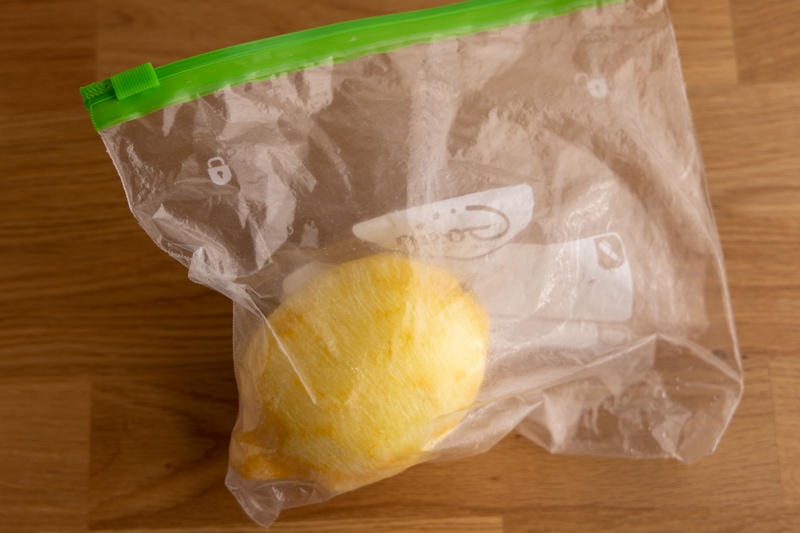
And here’s what you end up with:
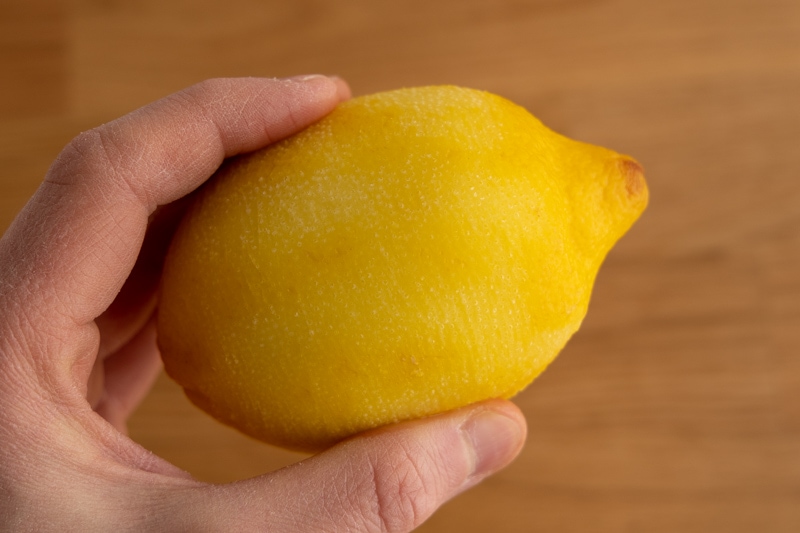
Usage
Freezing a whole lemon gives you the most options to use it after thawing. Depending on your needs, you can zest it, slice it, juice it, or do a combination of the three.
Of course, the whole fruit will be soft, so don’t expect the slices to be anywhere near fresh lemon slices quality-wise.
If you’re looking for ways to use lemon slices, check out the section on freezing slices for a few pointers. When it comes to lemon zest and juice, I have separate articles on those with a bunch of usage examples:
Freezing Lemon Slices
How to Freeze Lemon Slices
- Prep. After slicing your lemons, consider peeling them and removing some of the white pith. Some recipes need the peel to be removed, while others not necessarily so, but if you’re going to do that at some point, it’s much easier when you’re working with a fresh, firm lemon than a soft, defrosted one.
Lemon slices before pre-freezing - Pre-freeze. Line a cookie sheet with baking paper or a silicone mat, and spread the slices so that they don’t touch each other. Freeze them for 2 to 3 hours, or until they freeze solid. It’s okay if you leave them in the freezer overnight too.
Pre-frozen lemon slices
- Transfer to a freezer bag. Take the baking sheet from the freezer and transfer frozen slices into a freezer bag. Next, squeeze out excess air and seal the bag tight. If you find it helpful, label the bag with the name and date.
Frozen lemon slices in a bag - Freeze for the long term. Put the bag in the freezer.
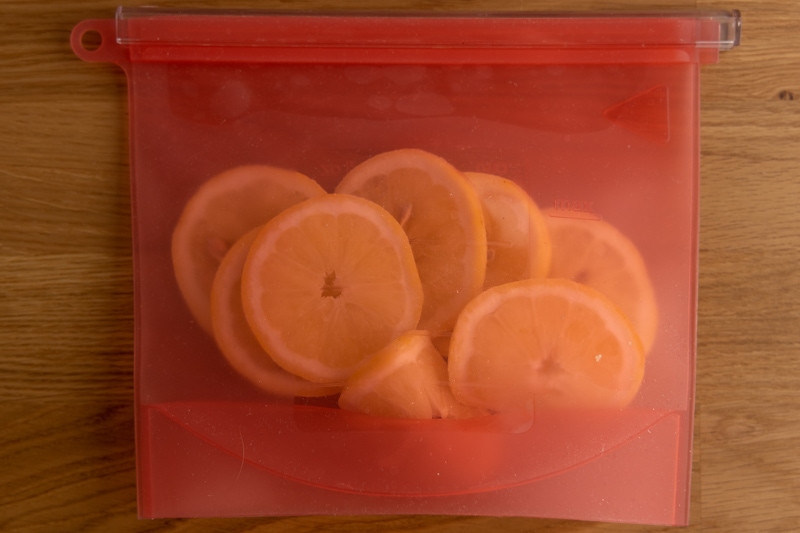
And that’s about it. The whole process is short and simple, and the only downside is that you can’t perform all the steps in one go.
Thanks to pre-freezing, you can freeze a bunch of lemon slices in one bag and still keep the option to scoop just one or two when needed. If you don’t care about this option, feel free to skip pre-freezing and just freeze all the slices in a bag.
(Just remember that they’ll freeze together into one big lump if you do so.)
Defrosting Lemon Slices
If you actually need the slices defrosted, you can thaw them overnight in an airtight container or freezer in the fridge. The whole process should take between 2 to 4 hours, so transferring them to the refrigerator in the morning is usually fine too.
The other option is to use the slices without defrosting them. If you just need to top your lemon salmon with a few pieces, chances are you can get away with using frozen ones. They’ll defrost in the oven in minutes, and your fish dish should turn out just fine.
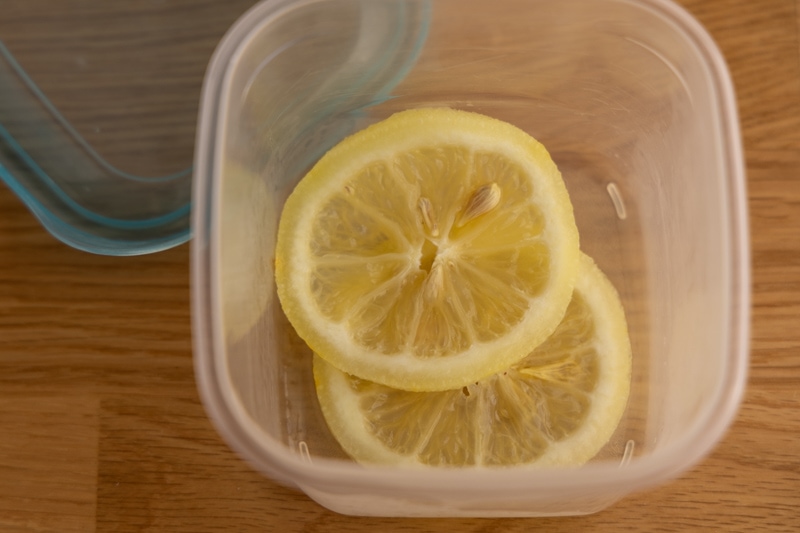
Using Lemon Slices
Frozen lemon slices work great in baked dishes (like a lemon salmon) and baked goods (like an upside down citrus cake). Or you can add them to your tea if you like.
Zesting slices doesn’t make much sense, and neither does juicing.
That means that using them in baking is the only way you can use frozen lemon slices.
(As I already mentioned, using frozen slices in garnishes isn’t a good idea. Unless you’re just practicing, of course.)
Because of the limited uses, I suggest going with freezing lemon slices only if you know exactly how you’re going to use them.
If you don’t have a plan in place, it’s probably better to freeze the whole lemon. You can always slice it and use those slices if need be, plus you retain other options, such as zesting and juicing the fruit.

Freezing Lemon Wedges
How to Freeze Lemon Wedges
Here’s how you freeze a quartered lemon:
- Pre-freeze. Grab a cookie sheet and arrange all the lemon pieces on it in a way they don’t touch each other. To simplify removing frozen parts from the sheet, you can line it with baking paper or a silicone mat. If you don’t line it, place the lemon quarters so that the rind is touching the cookie tray. This way, they won’t freeze to the tray. Once they’re spread out, put the cookie sheet in the freezer for 4 to 6 hours or until the lemons freeze solid. For simplicity, you can leave them in the freezer overnight.
Lemon halves & quarters before pre-freezing Pre-frozen lemon halves - Transfer into a freezer bag. Take the frozen lemon wedges from the freezer and transfer them into a freezer bag. Squeeze out all the air from it and seal the bag tight. Label the bag with its contents and date if you like.
Pre-frozen lemon quarters & halves - Freeze. Chuck the bag in the freezer for the long term.
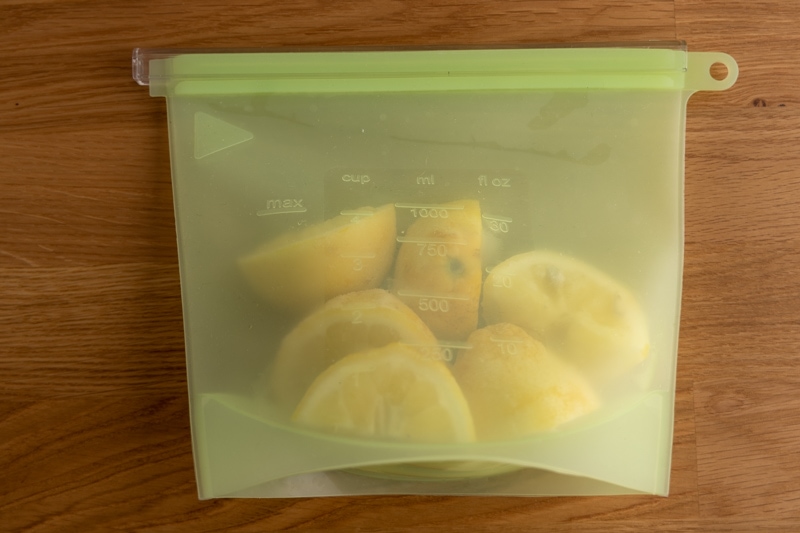
That’s it.
The pre-freezing step is there so that the lemon chunks don’t freeze together. If you don’t mind them all freezing into one big lump (e.g., you’re going to defrost all of them at the same time anyway), feel free to skip this step.
Defrosting Lemon Wedges
Defrost lemon quarters and halves overnight in an airtight container or freezer bag in the fridge. The whole process should take 4 to 8 hours, so it’s best to start it the day before you need the lemons defrosted.
After you defrost your lemon pieces, you should see something like this:

As you can tell, there’s not much (if any) extra liquid on the plate after defrosting, but the lemons are super soft and squishy. At this point, they’re ready for use.
Usage
Lemon quarters and halves are great for juicing, so if you need some fresh lemon juice, you defrost as many wedges as you need and squeeze them.
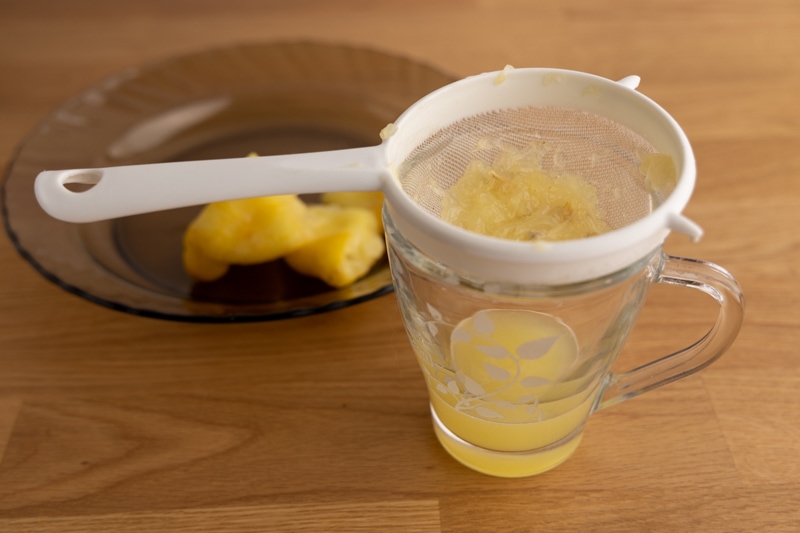
Again, those lemons are only good enough to juice yourself. So if you want to serve fish with lemon wedges for dinner, use fresh lemons.
When it comes to zesting, it’s not as easy as zesting a whole lemon, but doable. Just make sure to do it when the lemon quarters are still frozen. And hurry up so that you don’t defrost the lemon while zesting it.
Rotten Records: Share Your Snap!
Caught some food past its prime? Upload your photo to “Rotten Records” and help others spot the signs of spoilage. Every image makes our food community safer and more informed!


